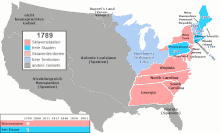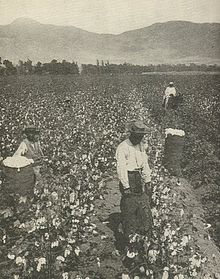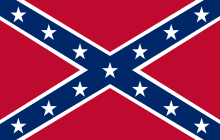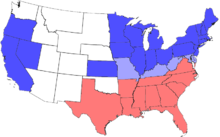Southern states
The southern states (also called Dixieland ) are a large region in the southeastern United States . According to the geographic definition of the United States Census Bureau , the southern states consist of a total of 16 states with almost 100 million inhabitants on 2,384,143 km². These are the 15 more eastern states that lie south of the Mason-Dixon Line , the border between Pennsylvania and Maryland , and where slavery was allowed until 1865 , as well as Oklahoma , which was only founded in 1907. The most populous of these states is Texas .
In a narrower sense, the term refers to the eleven of the slave-holding states that split off from the Union in 1860/1861 after Abraham Lincoln was elected US President . Lincoln hadn't called for the abolition of slavery because it was a state matter, but the Northern Republican proved that someone could be elected president without the support of the South. The eleven states formed the Confederate States of America , but were subject to the Northern States in the Civil War (1861-1865). The restored state as a whole enacted measures to improve the health of the black population and ruled the southern states directly during the reconstruction period . The understanding of the southern states as primarily a politically and culturally defined greater region is based on this historical background.
Definitions

Southern states, in the narrower sense, are those states that renounced the Union in 1860/1861 or joined the Confederate States . In February 1861, the Confederate States initially included South Carolina , Mississippi , Georgia , Louisiana , Florida and Alabama ; between March and July 1861 joined Texas , Virginia , Arkansas , North Carolina and Tennessee .
These eleven states were all slave-holding states , but some slave-holding states stayed with the north: Missouri , Kentucky , Maryland , Delaware . During the Civil War, West Virginia broke away from Virginia and joined the north in 1863. The District of Columbia , the capital Washington, knew slavery as early as 1860. Seen in this way, the capital district can be counted among the slave-holding areas that have not joined the Confederate.
Often the southern states are simply equated with the states in which slavery was allowed. However, this was still the case in some New England states around 1800.
According to the determination of the United States Census Bureau , the southern states (more precisely, the geographic greater region South = "south") in addition to the eleven states mentioned above include five other states (from east to west: Delaware, Maryland, West Virginia, Kentucky and Oklahoma ), as well as the capital region (District of Columbia).
Sub-areas of the southern states are designated as follows:
- Old South : the (slave-holding) southern states among the 13 founding states of the USA . Mostly the east coast states Delaware, Maryland, Virginia, North Carolina, South Carolina and Georgia are counted to the Old South.
- Upland South or Upper South: the northern parts of the southern states, especially those that joined the Confederate States after they were founded, i.e. Texas, Virginia, North Carolina, Tennessee and Arkansas. In a broader sense, one can also count the states that remained in the Union.
- Deep South : the southern states of South Carolina, Georgia, Florida, Alabama, Mississippi, and Louisiana.
- Lower South : This term is either equated with the Deep South or, according to the historian Ira Berlin, narrowed to the southeastern states of South Carolina, Georgia and Florida.
geography
Important geographical features are (from east to west) the Atlantic coast , the Appalachian mountain range , the Mississippi River and the vast landscapes of Texas .
Most of the southern states have a humid subtropical climate. The soils are mostly fertile, the safe frost-free period is more than six months. Typical plants in the area are live oak , magnolia , dogwood and incense pine .
story
Pre-colonial period
Around the year 800, stratified societies first developed in the area , profiting from an economic surplus. The Mississippi culture is particularly remarkable. The Indians practiced agriculture (especially corn ) and began to settle in cities. The largest city of the Mississippi culture, Cahokia , located near the confluence of the Missouri and Mississippi rivers, had a population of around 20,000 in the 12th century. The extent to which this development was influenced by the Indians of Central America has not yet been conclusively researched.
However, civilizations began to decline around the 13th century. The population decreased, cities were abandoned. The expedition Hernando de Sotos in the 16th century found many places that had obviously been abandoned for a long time, the exchange of tribes and cultures with one another was only a faint reflection of what can be read from archaeological finds from earlier times.
The inhabitants of the area belonged to the language families of the Sioux ( Quapaw , Biloxi ), Algonquian language family ( Pamunkey , Shawnee ), Iroquois languages ( Cherokee , Tuscarora , Westos ), Caddo ( Hasinai , Kadohadacho , Natchitoches ), the Gulf languages ( Atakapa , Chitimacha , Natchez , Tunica ) and Timucuan ( Apalachee , Choctaw , Oristas , Cusabos , Chickasaw , Guales , Alabama , Muskogee ).
Colonial time
The first Spanish expeditions were carried out in 1527/28 by Pánfilo de Narváez and Álvar Núñez Cabeza de Vaca and in 1539/40 by Hernando de Soto, who penetrated far inland. Although it is still historically controversial, the decline of the Mississippi culture began long before the expeditions of the Spaniards, but they deal another serious blow with their weapons and, above all, the diseases that have been introduced to the natives.
In 1585 Walter Raleigh founded the first English settlement on what is now the United States. It was on Roanoke Iceland ( North Carolina based), however, was not to last. It was not until 1607 that the English succeeded in establishing the first permanent settlement of Jamestown in Virginia . Like New England , the south was first populated by English Protestants. Other religious communities were added later.
Antebellum
Admission to the Union from 1776
In 1776, of the 13 founding states of the United States, six were slave-holding southern states: Delaware , Maryland , Virginia , North Carolina , South Carolina, and Georgia . Kentucky , 1796 Tennessee , 1812 Louisiana , 1817 Mississippi and 1819 Alabama were also admitted to the Union as slave states . Missouri , which joined the Union in 1821, Arkansas , which joined the Union in 1836, and Florida and Texas since 1845 were also considered southern states . All of these states allowed slavery.
In elections to the American President and the House of Representatives , the number of electors or MPs sent by a state depends on its population. Therefore, it was an important controversy whether the slaves, who lived mainly in the south, would be included in the calculation. In the Great Compromise of 1787, which clarified such and similar questions, it was decided that three fifths of the slaves should be counted. This regulation lost its meaning after the abolition of slavery in 1865. Ironically, as a result, the southern states received more representatives than before, even though the former slaves did not necessarily become electoral citizens.
economy
Between the 1790s with the invention of the Egrenier machine by Eli Whitney and the American Civil War, cotton became the primary agricultural commodity. During this time it made a significant contribution to supplying the British textile industry. Several million hectares of former wilderness have been opened up; The process was accompanied by intensive modernization. The same number of workers who could work one hectare of cotton around 1800 worked twelve hectares around 1850, supplemented by corn fields and other fruits for self-sufficiency. The development of the paddle steamer , as well as the expansion of the railroad for transport and the introduction of the telegraph, fell into this period.
While people in most of the southern states were still self-sufficient around 1800 , there were intensive trade relations with the northern states in 1860 and almost all consumer goods and machines were imported. The center of the cotton industry was the state of Mississippi and especially the southern area of Vicksburg along the Mississippi River with the urban center of Natchez .
slavery
The slaves in the southern states were born there as slaves or came into the country through the Atlantic slave trade until 1808 the importation of slaves into the USA was banned.
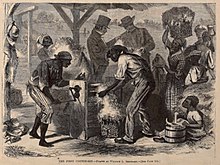
The slave labor on the tobacco and cotton farms and plantations of the southern states differed from the previously established slave labor on the Caribbean sugar cane plantations . Tobacco and cotton cultivation was less force-intensive than sugar cane cultivation - the slave owners could afford to own about half of them women. They supported the founding of families, as these not only provided for (monetary) offspring, but also prevented possible uprisings, as those potentially involved had much more to lose than in the Caribbean. In addition, riots in the southern states were less frequent than in the Caribbean, as slave riots were nipped in the bud by a well-organized militia . Furthermore, the proportion of slaves in the total population was much lower than, for example, on the British island of Jamaica , where the whites made up only a very small colonial upper class.
The slave labor was done either according to the gang system or according to the task system . In the gang system, the slaves worked the whole day under a (mostly enslaved) overseer, in the task system they were given a certain task and were free if they managed to do it before the allotted time.
In addition to the majority of the slaves who worked on the plantations and farms, there were also house slaves and skilled workers. The latter were often rented out to artisans in the nearby towns when there was no work on the farm, which usually allowed these slaves to live a little more freely. The chances of being officially released were slim. Traditionally the owners had the right to release their slaves into freedom, but mostly they only applied this to their own (unrecognized) children with female house slaves. In the last few years before the secession, the fear began to grow that freed people would incite the slaves to unrest, the right of release was partially shifted to the governor of the individual states.
Of course, slaves tried to escape too. With the help of sympathizers and abolitionists , this was achieved, for example, through the Underground Railroad . While riots were rare, sabotage was more common. The technically trained slaves in particular had both the technical understanding and the ability to cause great damage to the machines of their owners without their own deeds becoming obvious.
The slave question
The abolitionist movement looked like a strong lobby group, although it had less power than the South feared. Although the northerners were against slavery on principle, they were also against rapid abolition in the south. They feared not only chaos and massacres in the south itself, but also a massive move of freed slaves to the north. Actions by the southern states, by which the abolitionist propaganda in the south was hampered, also displeased northern states, who saw the freedom of the press at risk.
For example, it was disputed whether a slave who had fled to the north should continue to be viewed as the property of his owner living in the south. A slave escape law of 1850 caused unrest, as slave owners in the north captured their slaves, or black people, who they called runaway slaves. The burden of proof of not having been a slave was on the person concerned. Overall, there were rather few cases, but there were bloody clashes between slave owners and slaves, as well as those who stood by them. The civil war-like conditions in Kansas were also bloody . There, advocates of slavery strove to manipulate the territory to gain power and allow Kansas to join the United States as a slave-holding state.
In 1857 the Supreme Court of the United States ruled that a runaway slave should not be granted citizenship by residing in a northern state. Ultimately, it is important to protect the constitutionally guaranteed property of the slave owners. The opponents of slavery feared that in the future slavery should also be extended to the north. Because if property rights were to continue to apply in the north, for example if a southerner can visit a northern state with his slaves, then ultimately a stay for longer or forever would also be permitted.
Another major point of contention between northern and southern states was the question of whether slavery should be introduced in the newly won territories of the west . The Northerners feared that upon introduction they would become a minority within the Union. For example, in 1820 the Missouri Compromise was reached , according to which slavery could only be introduced south of a certain line. In the long run, however, the southern states fell behind with few newly admitted states allowing slavery. This was not least due to climatic reasons, as slave-based agriculture in the north was not profitable and there was no need for slaves. Trade regulations that made it difficult for the south to import processed goods from countries other than the northern states were also controversial.
The well-founded fear of the southern states was that they would lose influence in the state as a whole and ultimately not be able to maintain their way of doing business. Since practically all immigrants to the USA settled in slave-free states, the proportion of the southern state population in the state as a whole fell: by 1830 it was 42 percent, by 1850 only 35 percent (and based on the whites only 23 percent).
By 1860, only South-backed candidates had become President of the United States. In that year, however, Abraham Lincoln was elected, whose new Republican Party was mainly based in the north. Personally, he was in favor of the abolition of slavery; but he respected the legal situation that left the slave question to the states. Only a constitutional amendment by a two-thirds majority could have abolished slavery across the United States.
Founding of the Confederation in 1860/61
Despite Lincoln's election, the southern states could have stayed in the Union and allowed slavery to continue. For fear of future developments, however, some of the slave-owning states decided to leave the Union ( secession ) and form their own state as a whole.
South Carolina announced its withdrawal from the Union in December 1860, before the newly elected president took office in March. The incumbent President James Buchanan was of the opinion that this exit was illegal, but on the other hand there was no legal basis for preventing it by force; he therefore remained inactive, although Lincoln urged him to act.
The secession of South Carolina was followed in January 1861 by the states of Mississippi , Florida , Alabama , Georgia and Louisiana . On February 4, 1861, a provisional congress was constituted in Montgomery, made up of representatives of these states, which founded the Confederate States of America (CSA) and adopted their own constitution on March 11 . Texas , whose declaration of resignation decided on February 1, 1861 at a convention in Austin , was approved by referendum on February 23 and thus came into force on March 2, was the last state that existed on March 4 and before Abraham Lincoln took office left the Union at the beginning of the Civil War and joined the Confederate States.
A turning point was the attack on Fort Sumter on April 12th and 13th, 1861. The fortress in the area of South Carolina was under federal administration and was taken by South Carolina. This started the real Civil War, and Virginia , Arkansas , North Carolina and Tennessee left the Union. After populous Virginia joined the Confederation, Richmond , the capital of Virginia, replaced Montgomery , the capital of Alabama, as the capital of the Confederation.
At a glance the dates of the exit from the Union:
- South Carolina: December 20, 1860
- Mississippi: January 9, 1861
- Florida: January 10, 1861
- Alabama: January 11, 1861
- Georgia: January 19, 1861
- Louisiana: January 26, 1861
- Texas: February 23, 1861
- Virginia: April 17, 1861
- Arkansas: May 6, 1861
- Tennessee: May 6, 1861
- North Carolina: May 20, 1861
Of the slave-holding states, only Maryland, Kentucky, Missouri and Delaware remained in the Union, with only the latter being considered to be permanent. The new state of West Virginia split off from Virginia in 1863 and joined the Union.
During the war, large swaths of the southern states were devastated by troops from the north, and the south suffered from a trade blockade controlled by northern naval forces. In addition, the south initially damaged itself by embargoing cotton, in false confidence in its own economic importance. The cotton stores in Europe, on the other hand, were full after several war warnings, and the textile industry there was currently experiencing a sales crisis.
European states such as Great Britain and France were in favor of a new state in North America, but initially did not dare to conflict with the Union. With the emancipation proclamation , with which the northern states declared slavery abolished, the northern states gained ground, especially in England, because there was already a strong anti-slavery movement there. England was effectively excluded from the war, as an intervention in favor of slave owners could not be enforced domestically. Without England, however, France was not ready to get involved either. Due to the industrial strength of the much more populous north, the south could not win, but large parts of the old officer corps of the federal army were southerners and the troops of the south fought more committed. On April 9, 1865, Southern General Robert Edward Lee surrendered . The last Confederate troops surrendered in Texas on June 23, 1865.
After the civil war, 1865
On April 15, 1865, at the end of the war, Lincoln was murdered while attending the theater in Washington. Shortly before, on January 31, 1865, the 13th Amendment to the United States Constitution finally abolished slavery throughout the United States. Lincoln's successor, Vice President Andrew Johnson (1865-1869), a southerner from Tennessee and Democrat , tried to win the people of the southern states back for the whole state through milder treatment. The Congress, however, feared that the old conditions in the south would continue almost unchanged. Therefore, the southern states were only allowed to send members to Congress again after substantial legislative reforms. At times the southern states were even ruled by representatives of the state as a whole (so-called carpet excavators ). The end of this reconstruction time is located in the year 1877, when the Republican Rutherford B. Hayes was elected President and he had the last Union troops withdrawn.

Nevertheless, African Americans in the southern states remained second-class citizens who were made difficult to vote by discriminatory measures. The basic features of racial segregation persisted into the 1960s, until the civil rights movement and the corresponding measures of the federal government under Lyndon B. Johnson . In addition, millions of blacks moved to the states of the north and west between 1940 and 1970, and whites to the south on the other hand.
politics
In political terms, the civil war led to a rarely broken rule of the Republican Party at the federal level, the first in 1932 by the New Deal coalition of Franklin D. Roosevelt was broken. This ushered in a phase of federal Democratic government until the 1960s, interrupted only by the Eisenhower government . In the south, on the other hand, the Democrats set the tone; for example, they made the governor of Texas from 1874 to 1979.
In and after the 1960s there was a realignment of voters and parties. While until then the Democrats had dominated the southern states almost unchallenged as former slave advocates and a strongly conservative force ( Solid South ), many whites now switched to the Republicans, who had replaced the Democrats as the more conservative party around the turn of the century. The desegregation policies of Democratic Presidents Kennedy and Johnson were one reason. This also explains the phenomenon that many whites in the south vote democratically at the state level but republican at the federal level.
The influx of Americans from the northern states to the economically strong south meant that the southern states became more populous and thus gained more weight at the federal level. On the other hand, this also changed the social composition and voting behavior in these states, which was reinforced by the immigrants from Latin America, the Hispanics .
The south from a cultural point of view
In the 19th century, all southern states had a strong agricultural focus in common - in contrast to the already largely industrialized north. Plantation economy was particularly widespread in the coastal plains. Therefore, in these states there was the peculiar institution , the "special institution" as the US Constitution called slavery. There were considerable economic differences between the plantation owners on the plains and the small farmers in the mountainous regions of the Appalachians. Therefore it came during the Civil War to "secession within the secession", the separation of West Virginia from Virginia and the attempted separation of East Tennessee from Tennessee.
The socio-cultural contrasts between north and south run through all social classes and parties and have shaped politics between the individual states and the federal government since the reconstruction phase. The white inhabitants of the southern states, who come from poorer sections of the population, are sometimes pejoratively referred to as rednecks . Some people in the south or those who come from there also speak a characteristic accent, the Southern Drawl .
The southern states include the so-called Bible Belt . This area is known for the intense practice of the Christian religion; not infrequently dozens of churches can be found even in small towns. Some religious groups like the Baptists also have their own southern associations.
Gospel , blues and country music originated in the southern states . New Orleans was and is an important center for blues and jazz , Memphis one for blues and soul . Nashville, Tennessee is the center of commercial country music. As the "birth" of rock 'n' roll is often the first shot of from Mississippi dating Elvis Presley in Memphis called. The Dixieland Jazz , the Dirty South and the Southern Rock are named directly after the southern states.
Also known is the southern cooking and its peculiarities like Cajun food , soul food , Tex-Mex and Creole cuisine .
Origin of the term Dixieland
A common synonym for the southern states is Dixieland or Dixie . According to one theory, the name is said to be derived from the Mason-Dixon line . This was the name given to the boundary line between Pennsylvania and Maryland , which the surveyors Charles Mason and Jeremiah Dixon had measured, and, more generally, the dividing line between the American states, south of which slavery was permitted and north of which it was prohibited. According to another theory, the name is derived from the French word "dix" (ten), which used to be found on ten-dollar notes produced by the state banknote printing company in New Orleans, which was at times French-speaking.
literature
- David Bateman, Ira Katznelson, John S. Lapinski: Southern Nation: Congress and White Supremacy after Reconstruction. Princeton University Press, Princeton 2020, ISBN 978-0-691-20409-3 .
- Donald E. Davis, Craig E. Colten, Megan Kate Nelson, Mikko Saikku, Barbara L. Allen: Southern United States: An Environmental History. ABC-CLIO, Santa Barbara 2006, ISBN 1-85109-780-5 .
- John B. Boles (Ed.): A Companion to the American South. Blackwell, Malden 2002, ISBN 0-631-21319-8 .
- Howard Temperley, Regionalism, Slavery, Civil War, and the Reintegration of the South, 1815–1877 . In: Willi Paul Adams (Ed.): The United States of America (= Weltbild Weltgeschichte 30). Fischer Taschenbuch Verlag, Frankfurt am Main, 1994; ISBN 3-596-60030-8 , pp. 71-124.
- various editors: The New Encyclopedia of Southern Culture. 24 volumes. University of North Carolina, Chapel Hill 1989-2013.
supporting documents
- ^ Howard Temperley, Regionalism, Slavery, Civil War, and the Reintegration of the South, 1815–1877 , 90.
- ^ Ordinance of Secession ( Memento of April 4, 2004 in the Internet Archive ) in full
- ^ Howard Temperley, Regionalism, Slavery, Civil War, and the Reintegration of the South, 1815–1877 , p. 122.
Web links
- Jon Meacham: Jon Meacham on the 'New South' . Newsweek magazine dossier on the transformation of the southern states, August 2, 2008



